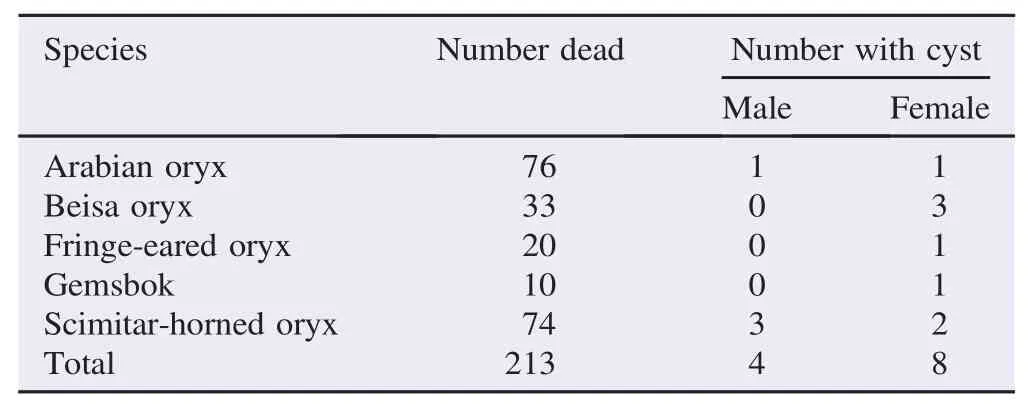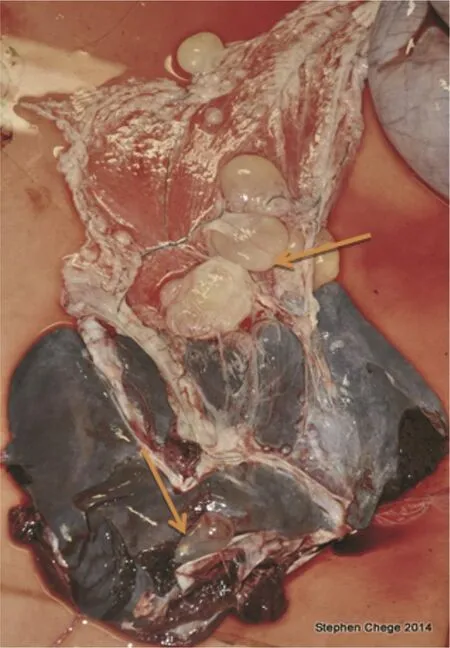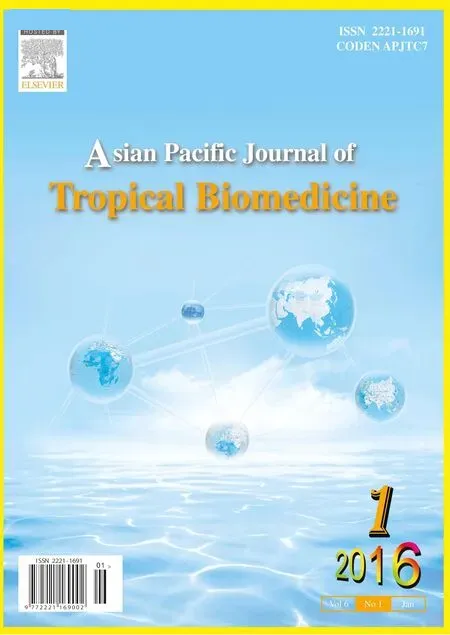Incidental findings of Cysticercus tenuicollis metacestodes in five oryx species
Incidental findings of Cysticercus tenuicollis metacestodes in five oryx species
Tel: +971 37992627
E-mails: stevmah@yahoo.com, Stephen.chege@alainzoo.ae
Peer review under responsibility of Hainan Medical University.
Foundation Project: Funded by Al Ain Zoo through a Grant Number 15/917001.
Stephen Chege*, Arshad Toosy, Ahmed Sakr, Ahmed Shawki, Sean O'Sullivan, Ana Perez de Vargas,
Tatiana Cavero, Amir Islam
Al Ain Zoo, Life Sciences Department, Veterinary Section PO Box 1204, Al Ain, United Arab Emirates
ARTICLE INFO
Article history:
Received 20 Apr 2015
Received in revised form 4 Jul 2015
Accepted 20 Sep 2015
Available online 10 Nov 2015
Keywords:
Al Ain Zoo
Arabian oryx
Beisa oryx
Cysticercus tenuicollis
Fringe-eared oryx
Gemsbok
Mortality records
Scimitar-horned oryx
Taenia hydatigena
ABSTRACT
Objective: To determine the prevalence of Cysticercus tenuicollis (C. tenuicollis) metacestodes in five oryx species kept in Al Ain Zoo animal collection.
Methods: This study was based on a retrospective analysis of post-mortem records covering a four year period (July 2010 to July 2014).
Results: A total of 213 individual animals were recorded dead during the four year period (July 2010 to July 2014). Out of this, 12 (5.6%) were recorded with C. tenuicollis. More females (8) than males (4) were recorded to have C. tenuicollis, although this was not statistically significant (P = 0.3737).
Conclusions: This study shows that, Arabian oryx, beisa oryx, fringe-eared oryx, gemsbok and scimitar-horned oryx are susceptible to C. tenuicollis. Based on the epidemiology and the life cycle of this parasite, it is possible that these captive animals ingested the parasite through contaminated feed which could have happened in the pasture land or stray dogs and wild canidae (e.g. fox) visited the zoo contaminating the oryx feed. Stray dogs and wild canidae should be prevented from visiting pasture land and a captive animal facility.
1. Introduction
Cysticercus tenuicollis (C. tenuicollis) is the larval stage (cysticercoid, metacestode) of Taenia hydatigena (T. hydatigena), a tapeworm parasite of dogs and other canids (coyotes, wolves, foxes, very occasionally cats) [1,2]. The intermediate hosts of T. hydatigena are domestic (sheep and goats) and wild ruminants (deer) [3]. The metacestode occurs worldwide, mainly in rural areas of countries with large sheep population.
Metacestodes are found attached to the omentum, mesentery, and occasionally on the liver surface; however, unusual locations of C. tenuicollis have been described as lungs, kidneys, brain, ovaries, uterine tubes, uterus, cervix, and vagina. The predilection site of adult tapeworms in their final host (dogs and other canids) is the small intestine [4]. Adult T. hydatigena tapeworm is found in the intestine of carnivores. The eggs hatch in the small intestine of the intermediate hosts and the released oncospheres enter liver through blood circulation. The metacestode migrate through the hepatic parenchyma to the peritoneal cavity [5]. It matures over a period of five to eight weeks and it is then found attached as a bladder worm called C. tenuicollis to the mesentery, serosal surface of the abdominal organs, and omentum[6].
Pathogenicity of adult parasites is not high for definitive hosts. However, large numbers of developing cysticerci migrate in the liver of intermediate hosts, producing hemorrhagic andfibrotic tracts known as“hepatitis cysticercosa”, a condition whose pathology resembles that of acute fasciolosis [3,7]. Severe infection of liver tissues may result in liver/carcass condemnation at slaughter and hence this is a disease of economic importance in livestock production [7].
Diagnosis of infection in animals is based on the finding of the cysts during meat inspection or necropsy procedure, although other methods such as ELISA, biochemical and hematological tests can be useful for diagnosis of live animals[7].
This study was aimed at documenting prevalence of C. tenuicollis metacestodes in five oryx species kept in Al Ain Zoo animal collection, through a retrospective analysis of postmortem records.
2. Materials and methods
This study was based on a retrospective analysis of postmortem records covering a four year period (July 2010 to July 2014) in Al Ain Zoo (latitude 24°10'45.37'N, longitude 55°44'19.99'E), Abu Dhabi, in the United Arab Emirates. The zoo hosts five oryx species, namely, Arabian oryx (Oryx leucoryx), beisa oryx (Oryx beisa), fringe-eared oryx (Oryx beisa callotis), gemsbok (Oryx gazelle) and scimitar-horned oryx (Oryx dammah). Post-mortem records were analyzed and only animals from the five species were included in the study. Data collected included: species, age, sex, presence/absence of cyst, location of cyst(s) and the cause of death of the animal. Data was entered in excel for analysis and GraphPad Prism®was used for statistical analysis.
3. Results
A total of 213 animals were recorded dead during the period under review (July 2010 to July 2014). Out of this, 12 were recorded with C. tenuicollis, accounting for 5.6% as shown in Table 1. Animals identified with the metacestode were all adults and more females (8) than males (4) were recorded to have C. tenuicollis, but not statistically significant (P value 0.3737, odds ratio = 0.485, 95% confidence interval 0.1416–1.664, Fisher's exact test, GraphPad Prism 6). The metacestodes were found attached in different organs as follows: lung (1), liver (1), liver and omentum (4) (Figure 1), omentum (4) and mesentery (2).

Table 1Number of animals from the 5 species recorded dead and diagnosed with C. tenuicollis metacestodes during the four year period (July 2010 to July 2014).

Figure 1. T. hydatigena cysts attached to the liver and omentum (indicated by arrow) in a scimitar-horned oryx.
4. Discussion
T. hydatigena is cosmopolitan in distribution and occurs in the small intestine of dogs, red foxes, wolves and other wild carnivores. The intermediate hosts are domestic and wild ruminants. The intermediate hosts get infected by ingesting feeds contaminated with dog or carnivore feces containing the eggs of T. hydatigena. Few pathological changes occur with T. hydatigena cysticerci infection, but severe infections can be hazardous to the animal's health. In our study, there was no noticeable pathology on the organs affected.
C. tenuicollis has been documented in Arabian oryx[8], beisa oryx [9], gemsbok [10], but to the best of our knowledge, it has not been documented in fringe-eared oryx and scimitar-horned oryx. In this study, the prevalence was low (5.6%) in contrast with higher prevalences reported in domestic animals (24.1% in sheep of Turkey[2], 79% in sheep and 53% in goats in Ethiopia [11], and 18.04% in goats and 28.4% in sheep in Iran [12,13]). This lower prevalence in the zoo animals may be due to the fact that the grazing behavior is different, as in captive facilities there is little contamination of feed with the parasite reservoir feces as compared to free-ranging livestock situation.
Only adults were found positive to C. tenuicollis and this is consistent with other findings[14], indicating that prevalence of C. tenuicollis increases with age, as older animals having lived longer pick large number of eggs during feeding of contaminated feed. Although more females than males were recorded with C. tenuicollis metacestodes, there was nostatistical difference between males and females. This is in contrast with other findings [2,12], who found that infestation in male sheep and goats was higher than in females.
Our study found that the predominant predilection sites for the metacestodes were the liver and omentum, followed by mesentery and lung, in contrast with others who reported that omentum [2,14] and liver [15] as the predominant predilection sites for C. tenuicollis.
There is very scanty information on the prevalence of C. tenuicollis or status in wildlife in the United Arab Emirates and hence further research is recommended.
Our study have shown that the five oryx species are susceptible to C. tenuicollis and based on the epidemiology of the life cycle of the parasite, it is possible that the captive animals ingested the parasite through contaminated feed which could have happened in the pasture land or stray dogs and wild canidae (e.g. fox) contaminated oryx feed in the enclosure. There is a need to have a barrier around the zoo premises as a biosecurity measure.
Conflict of interest statement
We declare that we have no conflict of interest.
Acknowledgments
We thank the management of Al Ain Zoo for their continued support and the veterinary team who have always strived to keep up-to-date data. Al Ain Zoo funded this work through a Grant Number 15/917001.
References
[1] Payan-Carreira R, Silva F, Rodrigues M, dos Anjos Pires M. Cysticercus tenuicollis vesicle in fetal structures: report of a case. Reprod Domest Anim 2008; 43: 764-6.
[2] Senlik B. Influence of host breed, sex and age on the prevalence and intensity of Cysticercus tenuicollis in sheep. J Anim Vet Adv 2008; 7(5): 548-51.
[3] Kara M, Doganay A. Investigation of antigenic specificity against Cysticercus tenuicollis cyst fluid antigen in dogs experimentally infected with Taenia hydatigena. Turk J Vet Anim Sci 2005; 29: 835-40.
[4] Utuk AE, Piskin FC. Molecular detection and characterization of goat isolate of Taenia hydatigena in Turkey. ScientificWorldJournal 2012; 2012: 962732.
[5] Nourani H, Pirali Kheirabadi KH, Rajabi H, Banitalebi A. An unusual migration of Taenia hydatigena larvae in a lamb. Trop Biomed 2010; 27: 651-6.
[6] Smith MC, Sherman DM. Liver and pancreas. In: Goat medicine. 2nd ed. Lowa: Wiley-Blackwell; 2009, p. 513-5.
[7] Radfar MH, Zarandi MH, Bamorovat M, Kheirandish R, Sharifi I. Hematological, biochemical and pathological findings in goats naturally infected with Cysticercus tenuicollis. J Parasit Dis 2014; 38(1): 68-72.
[8] Mohammed OB, Alagaili AN, Omer SA, Hussein MF. Parasites of the Arabian oryx (Oryx leucoryx, Pallas, 1777) and their prevalence in the Kingdom of Saudi Arabia. Comp Parasitol 2012; 79(2): 288-92.
[9] Arora BM, Varma TK, Tewari HC, Mandal CK. Cystercosis caused by Cysticercus tenuicollis in a Beisa oryx. Vet Rec 1984; 114: 197.
[10] Fourie LJ, Vrahimis S, Horak IG, Terblanche HJ, Kok OB. Ectoand endoparasites of introduced gemsbok in the Oregon Free State. S Afr J Wildl Res 1991; 21(3): 82-7.
[11] Sissay MM, Uggla A, Waller PJ. Prevalence and seasonal incidence of larval and adult cestode infections of sheep and goats in eastern Ethiopia. Trop Anim Health Prod 2008; 40: 387-94.
[12] Oryan A, Goorgipour S, Moazeni M, Shirian S. Abattoir prevalence, organ distribution, public health and economic importance of major metacestodes in sheep, goats and cattle in Fars, southern Iran. Trop Biomed 2012; 29(3): 349-59.
[13] Singh BB, Sharma R, Gill JPS, Sharma JK. Prevalence and morphological characterization of Cysticercus tenuicollis (Taenia hydatigena cysts) in sheep and goats from north India. J Parasit Dis 2015; 39(1): 80-4.
[14] Samuel W, Zewde GG. Prevalence, risk factors and distribution of Cysticercus tenuicollis in visceral organs of slaughtered sheep and goats in Central Ethiopia. Trop Anim Health Prod 2010; 42(6): 1049-51.
[15] Mekuria E, Shimelis S, Bekele J, Sheferaw D. Sheep and goats Cysticercus tenuicollis prevalence and associated risk factors. Afr J Agric Res 2013; 8(24): 3121-5.
*Corresponding author:Stephen Chege, Al Ain Zoo, Life Sciences Department, Veterinary Section PO Box 1204, Al Ain, United Arab Emirates.
 Asian Pacific Journal of Tropical Biomedicine2016年1期
Asian Pacific Journal of Tropical Biomedicine2016年1期
- Asian Pacific Journal of Tropical Biomedicine的其它文章
- The antibacterial activity of selected plants towards resistant bacteria isolated from clinical specimens
- Evaluation of antibacterial activity and synergistic effect between antibiotic and the essential oils of some medicinal plants
- Comparative studies of elemental composition in leaves and flowers of Catharanthus roseus growing in Bangladesh
- Formulation and evaluation of semisolid jelly produced by Musa acuminata Colla (AAA Group) peels
- Prevalence of multi-drug resistant uropathogenic Escherichia coli in Potohar region of Pakistan
- Antibiotic resistance profile and RAPD analysis of Campylobacter jejuni isolated from vegetables farms and retail markets
